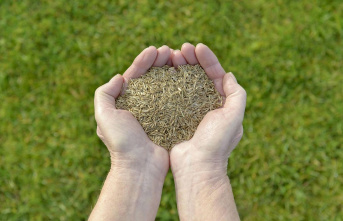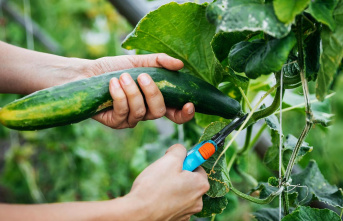A few apples and pears are still hanging on the trees. The last tomatoes are still turning red. Otherwise there isn't much to get in the many small gardens in our latitudes in October. So putting your feet up now or under the cozy blanket and leaving the garden to itself until spring is foolish. Everything that you can still do before the first frost, you should definitely do. Above all, the beds, the lawn and many perennials will thank you. So use the golden autumn to prepare the garden for the approaching winter. Otherwise there is a risk of some nasty surprises after the snow.
Three of the most important gardening tasks in October, which tools you need and why it has to be now.
If you want to enjoy your green again in spring, you can't avoid scarifying your lawn in autumn. First of all, the right timing is important here. Sometimes you need a bit of luck for that. Before the lawn can be aerated and moss and other lawn weeds can be removed, the lawn mower has to get to work. Ideally, you should put it into operation on a day without rain. In the best case, the lawn is completely dry. This not only saves time, but also the material. Important: Autumn is not the season for English lawns. Don't prune the stalks more than four to five centimeters. In this way, they can make maximum use of the little light on the shorter days for photosynthesis. It also helps you keep moss and unloved lawn weeds in check.
After a few days of rest, it's time for the scarifier. Especially when thatch has spread in late summer, robbing the blades of air to breathe and the roots of oxygen. When scarifying, make sure that the sharp knives scratch the turf a maximum of two to three millimeters deep. In any case, less is more here. Once the roots are damaged, you have little chance of saving the lawn. Drive the lawn lengthwise and crosswise and then collect the lawn thatch that you have loosened from the turf. Bare areas look forward to a handful of lawn seeds at least in early to mid-October. With a bit of luck and the last strong rays of sunshine in the golden autumn, the seeds will germinate in time.
The colorful autumn leaves are currently romping around not only on the lawn, but also on the flower beds. This has advantages, but also disadvantages. The wet leaves have no place in the meadow. Because they deprive the lawn of the rare sunlight anyway, they should be swept up and collected regularly - at least every two weeks - with a rake or leaf brush. Electric leaf and lawn collectors are a little more convenient. The best thing about it: most of them are so quiet that you can work with them on Sundays and public holidays without a guilty conscience.
What is poison for the lawn offers beds and perennials ideal frost protection during the first cold nights. So don't throw the swept up autumn leaves in the neighbor's garden or in the green waste. Spread it generously on your beds and raised beds, under cold-sensitive perennials and sun-kissed herbs. The leaf mulch can also protect the root area of strawberries, raspberries and other soft fruits from the nasty consequences of minus temperatures. In addition, the slowly decomposing leaves activate soil life because humus and nutrients are created that help the plants in the next growth phase. If you can't save yourself from leaves, it's best to use them to build a shelter for toads, hedgehogs and other useful animals. How it works? Rake leaves into a large pile. Finished.
Apart from classic winter vegetables, there shouldn't be much going on in the beds in October. The tomatoes have been harvested, the peppers are catching the last rays of the sun. It's time to prepare the beds for winter. The old plants have to be removed first. If the soil is damp, this is usually child's play. It is best to dispose of the plant remains in the compost. Then the garden weeds, which have spread in the beds in late summer, are on the loose. This is important now because many of the plants are now losing their seeds. So if you get a garden hoe and weed puller out of the shed now, you will save yourself a lot of work in the spring. Collect the weeds in a garden waste bag (e.g. from GardenGloss) and later dispose of the greens in the organic waste bin. The soil should be thoroughly loosened and aerated. To top it off, cover the soil with a layer of fall leaves. In this way you prevent the soil from drying out and at the same time activate soil life. Because when the leaves decompose, important nutrients are created that are stored in the soil and make life easier for the plants in the coming garden year.
By the way: the berries and ornamental beds also look forward to a warming layer of autumn leaves. Alternatively, you can also work with commercially available bark mulch or material that you have produced yourself with the garden shredder.












